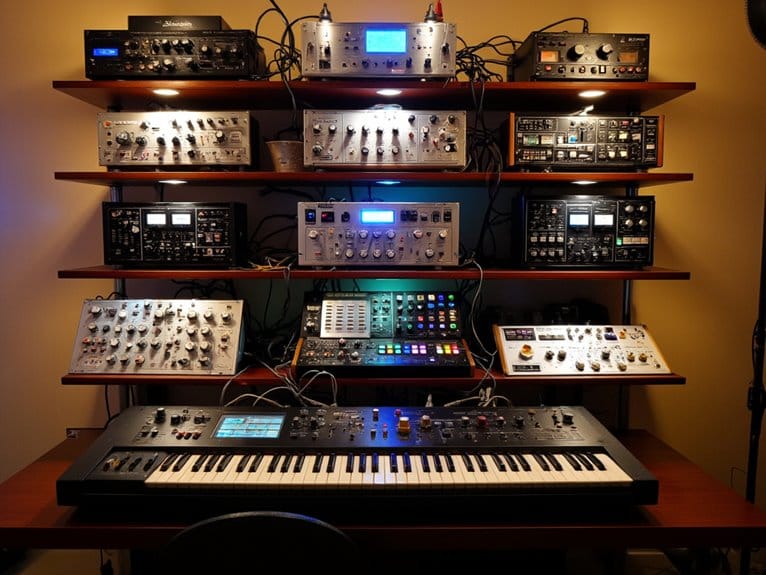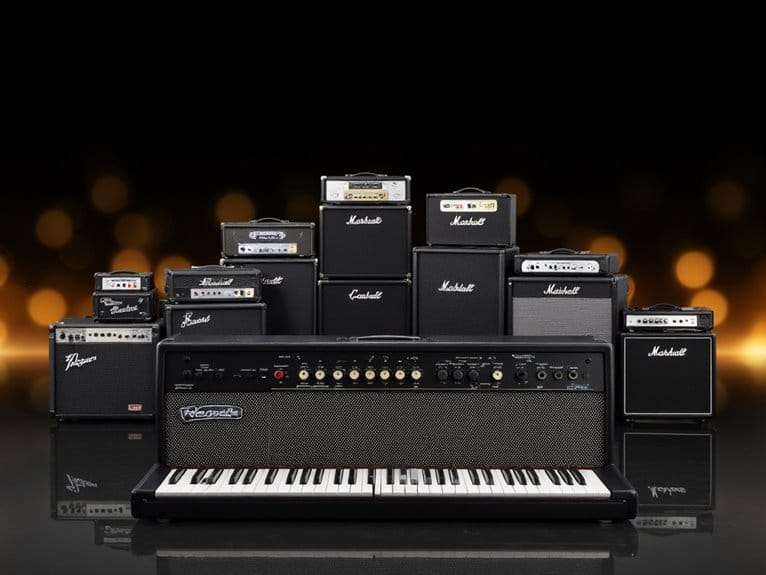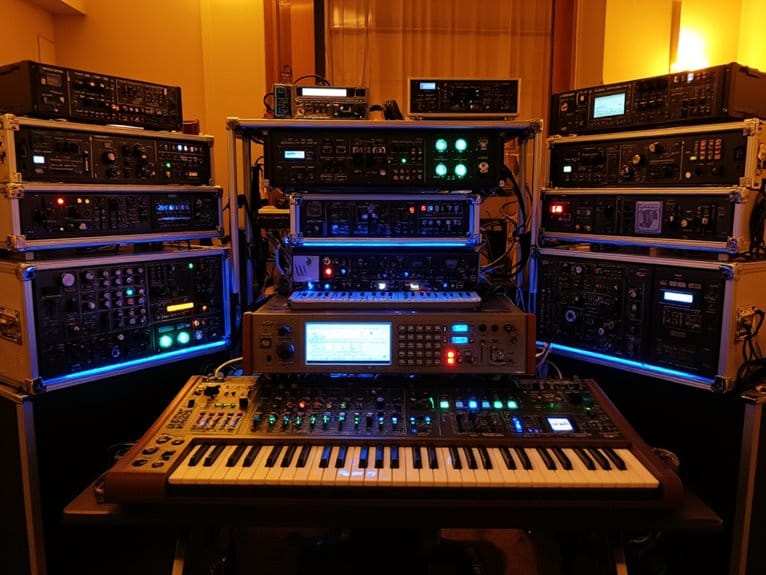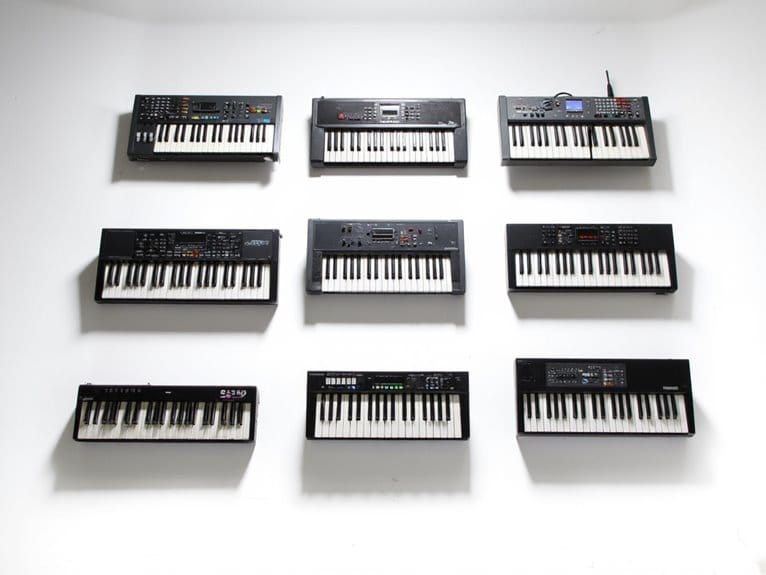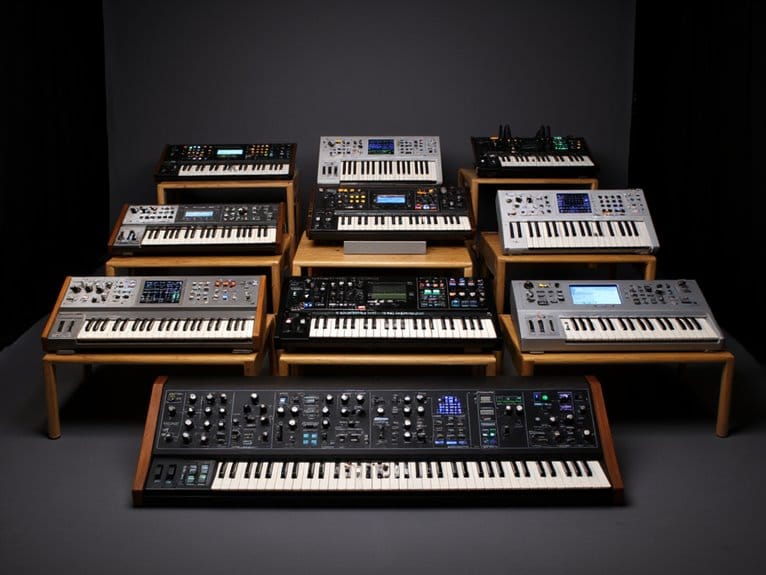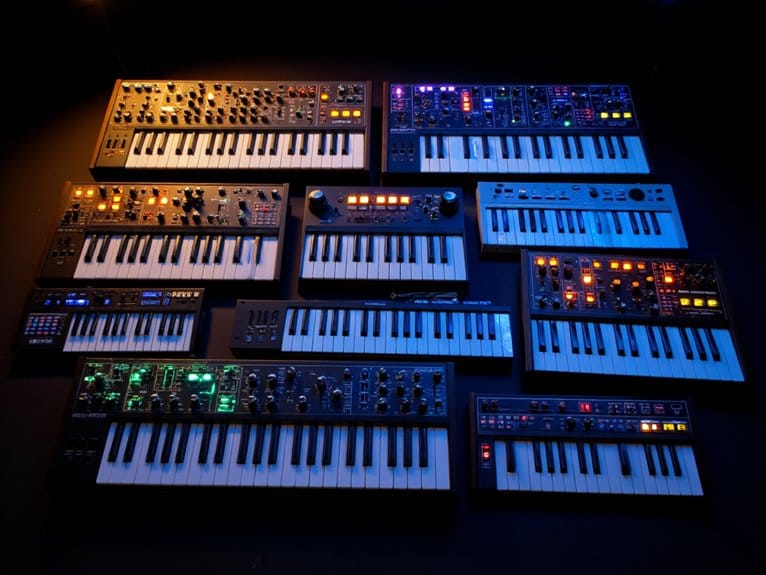10 Best Desk Synthesizers That Will Transform Your Home Studio
I’ve tested countless desktop synthesizers, and the standout performers include the Teenage Engineering OP-XY with its 64-step sequencer and randomization features, the Hydrasynth’s 8-voice polyphonic wave morphing engine with 219 waveforms, and the authentic analog MOOG Minitaur with its iconic ladder filter and 128 presets. The Behringer 2600 GRAY MEANIE offers semi-modular flexibility, while Roland’s SH-4d delivers impressive 60-voice polyphony. Each brings unique capabilities that’ll elevate your studio workflow beyond expectations.
We are supported by our audience. When you purchase through links on our site, we may earn an affiliate commission, at no extra cost for you. Learn more.
Notable Insights
- Desktop synthesizers offer space-saving designs weighing 1-5 pounds while providing professional sound quality for compact home studios.
- High polyphony models like Roland SH-4d (60 voices) and Behringer UB-Xa (16 voices) enable complex layered arrangements.
- Hands-on control interfaces with multiple knobs and sliders eliminate menu diving for intuitive real-time sound manipulation.
- Built-in sequencers with randomization features and comprehensive modulation systems expand creative possibilities for electronic music production.
- Analog models like Moog Minitaur provide authentic warmth while digital options offer extensive preset libraries and sound design flexibility.
Teenage Engineering OP-XY Portable Synthesizer & Sampler
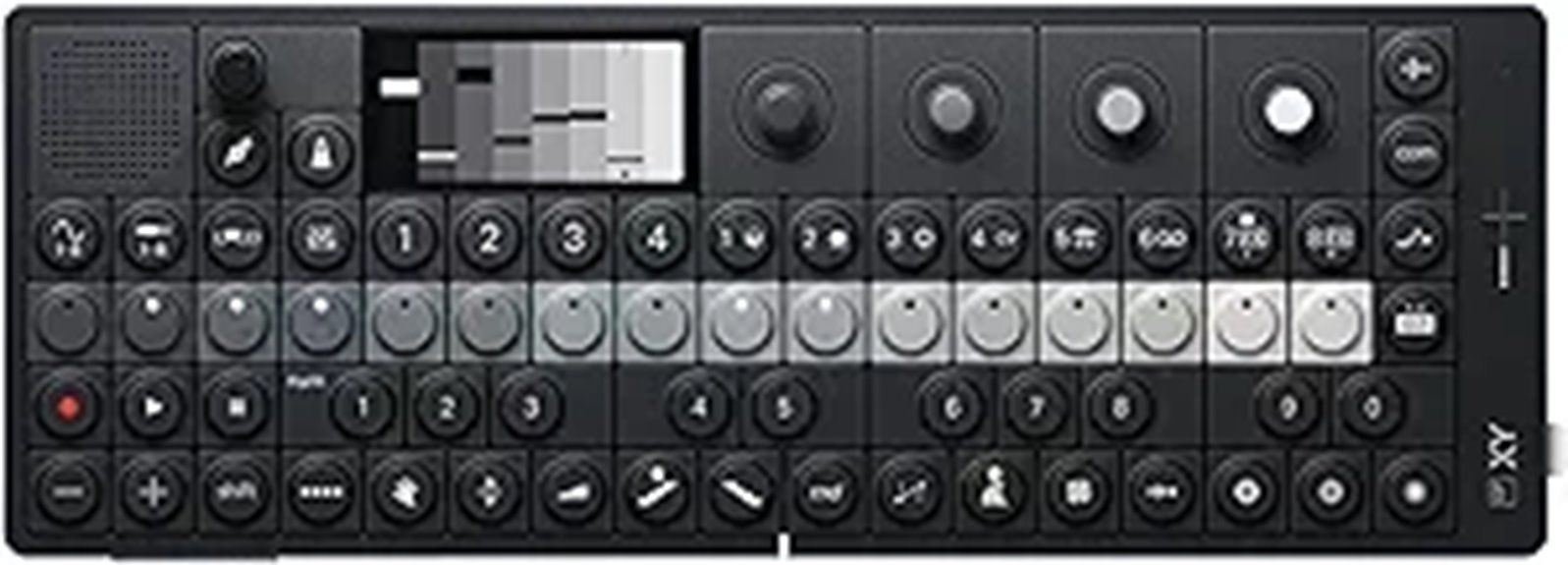
I’ve spent countless hours testing portable synthesizers, and the Teenage Engineering OP–XY stands out as the ultimate creative powerhouse for producers who need studio-quality sequencing capabilities in a truly portable package. You’ll appreciate its dual-CPU architecture, which drives eight individual instrument tracks alongside eight auxiliary tracks for external gear control, creating polyrhythmic possibilities through independent track speeds and lengths. The 64-step sequencer delivers ultra-fast workflow changes with punch-in effects, while randomization features manipulate note timing, velocity, and pitch for unexpected musical discoveries. Advanced I/O connections include main output, 4-in-1 multi-out jack, MIDI-in, USB Type-C, and Bluetooth LE wireless control.
Best For: Music producers and electronic musicians who need a portable, professional-grade sequencer with advanced polyrhythmic capabilities and extensive connectivity options for both studio work and live performances.
Pros:
- Dual-CPU architecture enables complex polyrhythmic sequencing with 8 instrument tracks and 8 auxiliary tracks running at independent speeds and lengths
- Comprehensive connectivity including main output, 4-in-1 multi-out jack, MIDI-in, USB Type-C, and Bluetooth LE for seamless integration with other equipment
- Advanced creative features like randomization controls, live automation, and step components for real-time sound manipulation and musical experimentation
Cons:
- Likely high price point typical of Teenage Engineering products may put it out of reach for budget-conscious musicians
- Complex feature set and workflow may require significant learning curve for users new to advanced sequencing
- Portable design may compromise on physical control surface size, potentially making detailed editing more challenging than full-size equipment
Behringer 2600 GRAY MEANIE Semi-Modular Analog Synthesizer
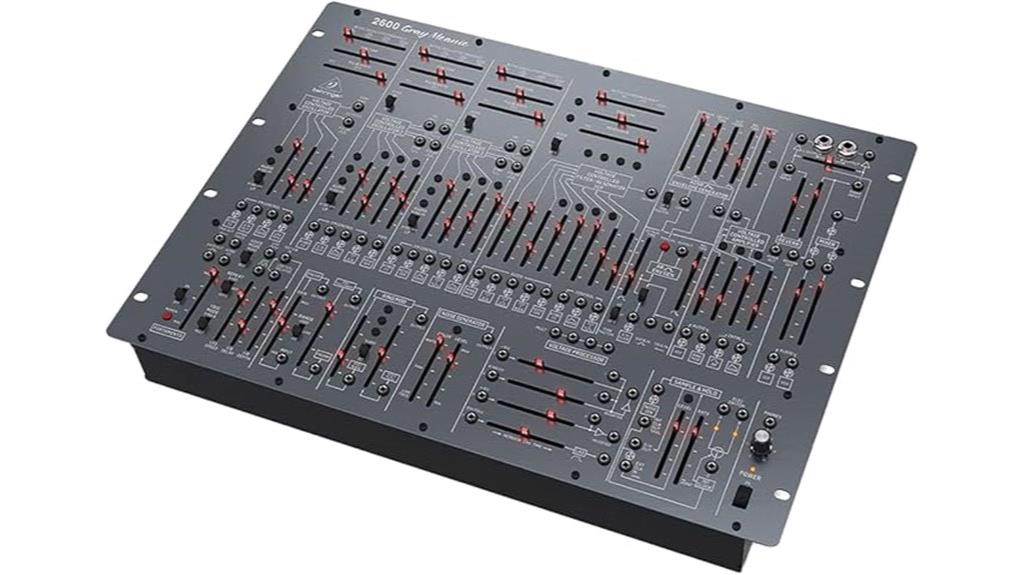
The Behringer 2600 GRAY MEANIE stands as a compelling entry point for producers seeking authentic analog synthesis without the financial burden of vintage gear, delivering three voltage-controlled oscillators, multi-mode filtering, and spring reverb in an accessible semi-modular format. You’ll appreciate that each VCO includes LFO mode and FM inputs, providing extensive sonic possibilities without requiring patch cables for basic operation. The authentic reproduction circuitry, featuring selected opamps and transistors from the original 1970s ARP design, delivers surprisingly fat analog sounds that customers consistently praise in reviews averaging 4.6 stars. While packaging concerns exist, the synthesizer’s versatility and affordability make it an excellent vintage alternative for home studios.
Best For: Producers and musicians seeking authentic analog synthesis at an affordable price point who want the versatility of semi-modular design without the complexity of requiring patch cables for basic operation.
Pros:
- Authentic analog sound reproduction with three VCOs, multi-mode VCF, and spring reverb delivering fat, vintage-quality synthesis
- Semi-modular design allows both simple operation without patching and advanced sound design possibilities with additional cables
- Excellent value proposition as an affordable alternative to rare vintage ARP synthesizers while maintaining authentic circuitry design
Cons:
- Packaging and shipping issues frequently reported, with potential for damaged components during transit
- Some units have reported defects, particularly with LED indicators and other components upon arrival
- Limited included patch cables may require additional purchases to fully explore the synthesizer’s creative potential
Roland JU-06A Sound Module with 8 Patches + 8 Banks
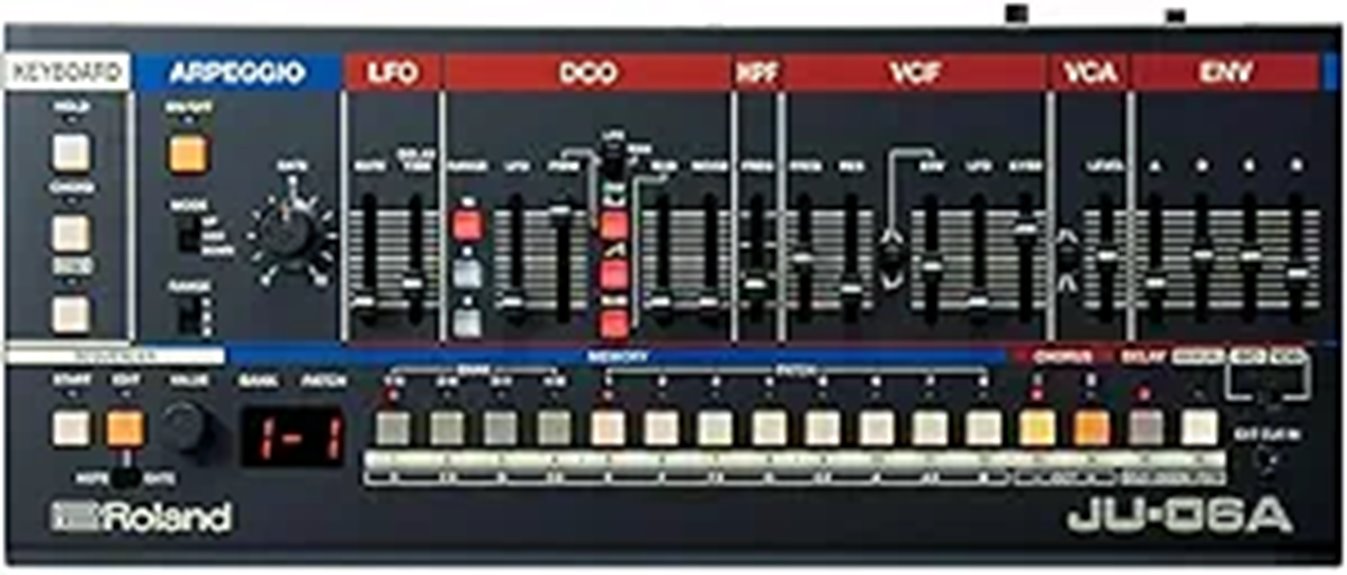
Studio producers seeking authentic ’80s synthesizer sounds without breaking the bank will find the Roland JU-06A Sound Module‘s dual-personality approach particularly compelling, as it faithfully recreates both the warm, deeper tones of the legendary JUNO-106 and the punchy, aggressive character of the JUNO-60 in a compact desktop unit. You’ll appreciate the 128 total patches across both modes, plus the built-in arpeggiator that wasn’t available on the original JUNO-106, giving you expanded creative possibilities for modern productions while maintaining that coveted vintage character that defined countless classic tracks.
Best For: Studio producers and synthesizer enthusiasts who want authentic ’80s JUNO synthesizer sounds in a portable, affordable desktop module with hands-on controls and dual vintage character modes.
Pros:
- Faithfully emulates both JUNO-60 and JUNO-106 synthesizers with 128 total patches and enhanced features like arpeggiator and velocity sensitivity not found on originals
- Portable battery-powered operation with built-in speaker makes it suitable for mobile production and various studio setups
- Solid build quality with full hands-on controls and multiple connectivity options including MIDI In/Out and USB
Cons:
- Limited 6-hour battery life with no included power supply option, requiring frequent battery changes or separate power adapter purchase
- Compatibility issues with certain MIDI devices and lacks some original JUNO features like CC in/out and full voice count
- Short sliders and missing USB cable in package may require additional purchases for optimal functionality
MOOG Minitaur Analog Bass Synthesizer Module
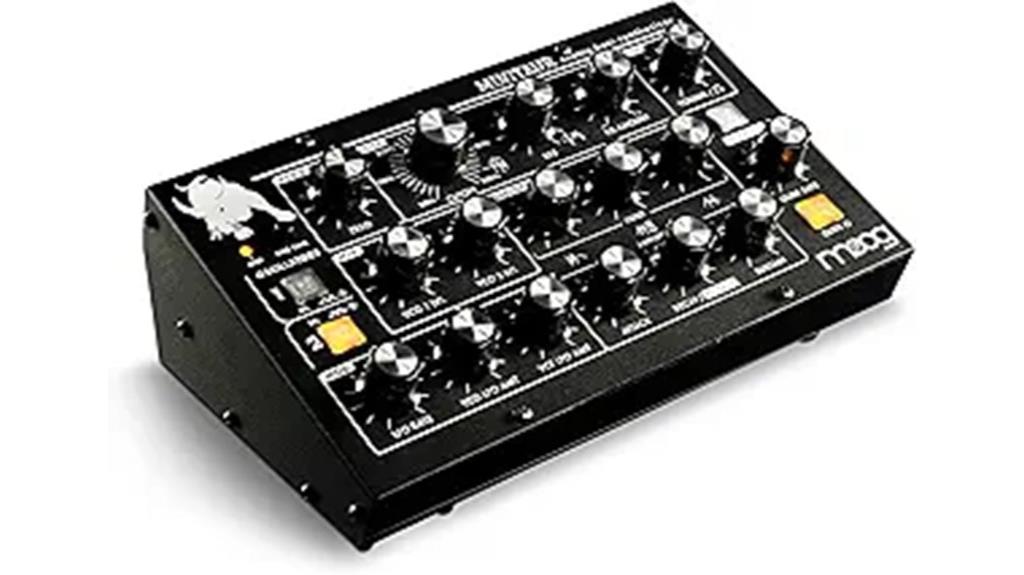
Bass enthusiasts who’ve been searching for that legendary Moog sound in a compact, affordable package will find their answer in the Minitaur Analog Bass Synthesizer Module, a desktop powerhouse that delivers nearly five decades of Taurus lineage heritage in a remarkably portable 1.2-kilogram form factor. You’ll appreciate the completely analog signal path featuring dual VCOs, the iconic Moog ladder filter, and dual envelope generators that create those deep, punchy low-end frequencies. The classic one-knob-per-function design makes programming intuitive, while 128 onboard presets provide instant gratification when you need solid bass foundations quickly.
Best For: Bass players, electronic music producers, and studio musicians seeking authentic analog Moog bass sounds in a compact, affordable desktop module with intuitive hands-on control.
Pros:
- 100% analog signal path with legendary Moog ladder filter delivers deep, punchy bass tones with nearly 50 years of Taurus heritage
- Classic one-knob-per-function interface provides immediate, tactile control without menu diving or complex programming
- Excellent connectivity options including MIDI, USB, and audio I/O with built-in headphone amp for versatile studio and live integration
Cons:
- Limited sound design capabilities compared to other synthesizers in the same price range, focusing specifically on bass sounds
- USB connection stability issues and software compatibility problems reported, particularly on MacOS systems
- Relatively narrow sonic palette due to bass-focused design may not suit users seeking broader synthesizer functionality
Hydrasynth Digital Polyphonic Desktop Synthesizer
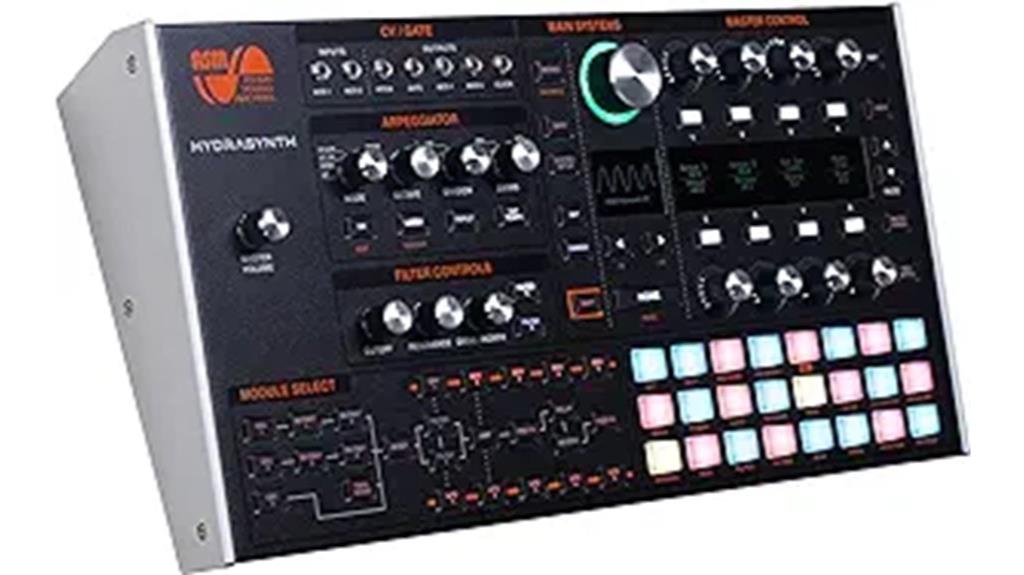
Sound designers and performing musicians who demand maximum creative flexibility will find their match in the ASM Hydrasynth Digital Polyphonic Desktop Synthesizer, a powerhouse that delivers the same 8-voice polyphonic wave morphing engine found in its keyboard counterpart. You’ll appreciate the streamlined workflow that minimizes menu diving, while the 24 polyphonic pressure touch pads let you create music without external controllers. The three oscillators access 219 single cycle waveforms, with dual Wave Mutators offering processes like FM-Linear and Harmonic Sweep for extensive sound shaping possibilities that’ll keep you exploring for hours.
Best For: Sound designers and performing musicians who need maximum creative flexibility with an 8-voice polyphonic wave morphing synthesizer that offers streamlined workflow and extensive modulation capabilities without requiring external controllers.
Pros:
- 219 single cycle waveforms across three oscillators with dual Wave Mutators for extensive sound shaping possibilities including FM-Linear, Wavestack, and Harmonic Sweep
- Comprehensive modulation system featuring 32 user-definable routings with 29 sources and 155 destinations, plus five LFOs and five DAHDSR envelopes
- 24 polyphonic pressure touch pads enable music creation without external controllers, while the streamlined interface minimizes menu diving for quick patch editing
Cons:
- Limited to 8-voice polyphony which may be restrictive for complex arrangements or layered performances
- Desktop format lacks built-in keyboard, requiring external MIDI controller for traditional keyboard playing experience
- No mention of built-in sampling capabilities or ability to import custom waveforms beyond the included 219 single cycle waves
Behringer UB-Xa D 16-voice Desktop Analog Synthesizer
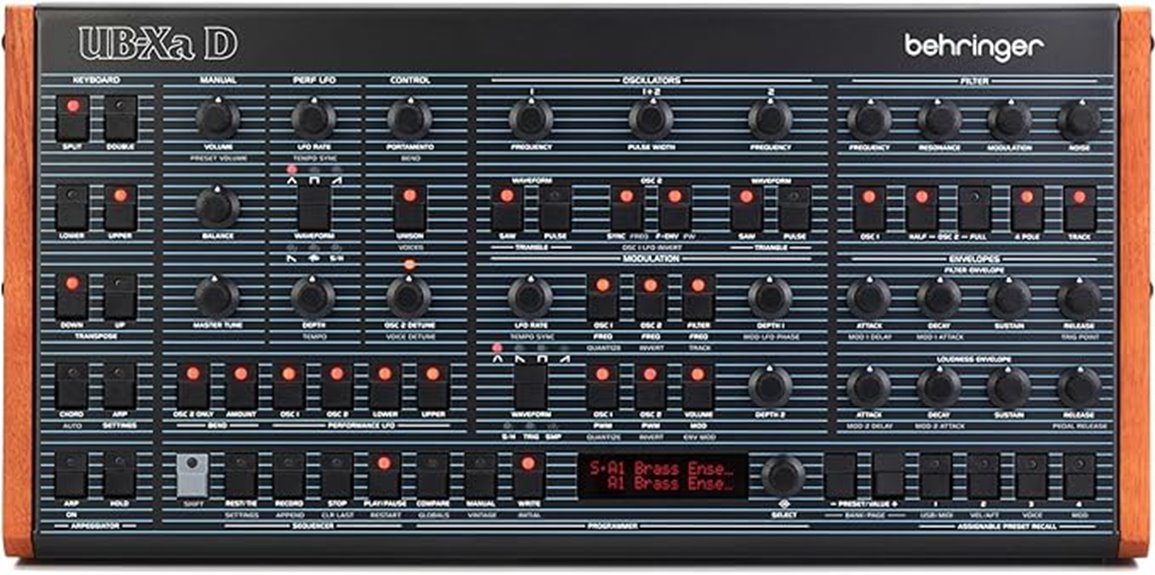
Polyphonic powerhouse meets compact convenience in the Behringer UB-Xa D, a 16-voice desktop analog synthesizer that transforms cramped home studios into sonic laboratories without demanding the real estate of a full-sized keyboard. You’ll discover 32 oscillators working across those 16 voices, creating rich, layered textures that’ll make your neighbors question their life choices. The eight vintage modes and multimode VCF provide sonic flexibility, while 512 user preset slots guarantee you won’t lose that perfect patch you accidentally stumbled upon at 3 AM. Though some users find the oscillators sound “thin” compared to pricier alternatives, you’re getting legitimate analog warmth.
Best For: Home studio producers and electronic music enthusiasts who need serious polyphonic analog synthesis capabilities in a compact desktop format without the space requirements of a full keyboard.
Pros:
- 16-voice polyphony with 32 oscillators delivers rich, layered analog textures for complex soundscapes
- Compact desktop design saves valuable studio space while maintaining professional synthesizer capabilities
- 512 user preset slots and 8 vintage modes provide extensive sound design flexibility and storage options
Cons:
- Oscillators described as sounding “thin” compared to higher-end analog synthesizers
- Limited customer feedback with only 3.5/5 star rating suggests potential quality or performance concerns
- Desktop-only format lacks built-in keyboard, requiring separate MIDI controller for hands-on playing
Roland SH-4d Compact Desktop Synthesizer
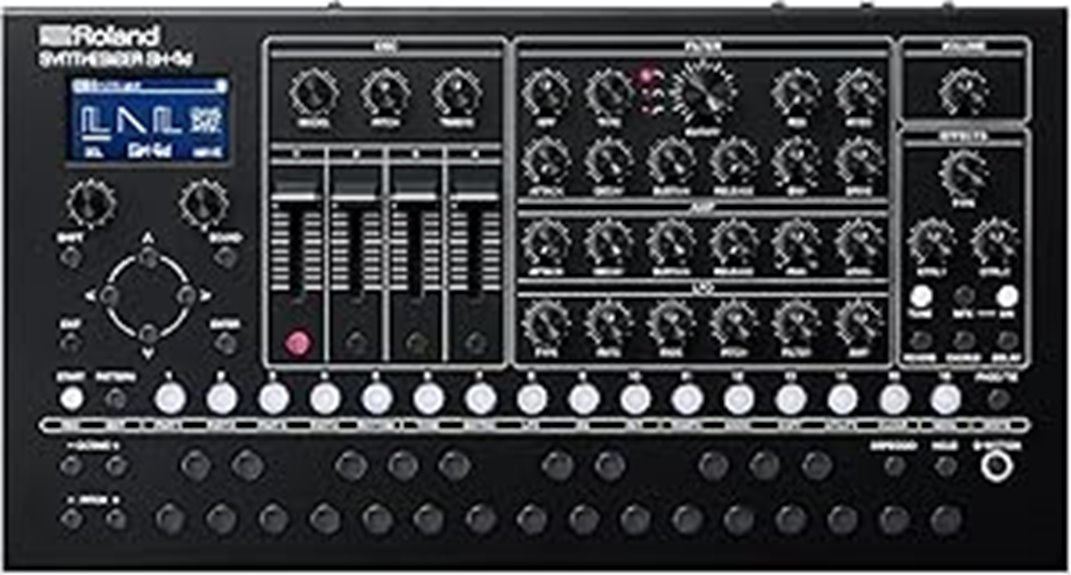
When I first encountered Roland’s SH-4d Compact Desktop Synthesizer, its combination of 11 oscillator models, multitimbral sequencing, and 60-voice polyphony immediately caught my attention as a compelling solution for producers who need versatility without sacrificing workspace real estate. You’ll find classic Roland sounds from the SH-101, JUNO-106, TR-808, and TR-909 packed into this 5.63-pound unit, along with 1,000 presets and 256 user patch slots. The 32 knobs and four sliders provide hands-on control, though I’ll admit the manual saving process feels unnecessarily convoluted for modern standards.
Best For: Producers and musicians seeking an all-in-one synthesizer, drum machine, and groovebox solution with classic Roland sounds in a compact, portable format for studio work, live performance, or travel production.
Pros:
- Combines versatile functionality with classic Roland sounds from legendary instruments like SH-101, JUNO-106, TR-808, and TR-909 in one compact unit
- Intuitive hands-on workflow with 32 knobs and four sliders for direct sound manipulation plus 60-voice polyphony
- Robust metal construction with comprehensive connectivity including USB-C audio/MIDI interface and battery power option for maximum portability
Cons:
- Sequencer limitations with only 64 steps per pattern and no song mode functionality for complete compositions
- Convoluted manual saving process without auto-save feature that can lead to lost work
- No sound expansion options or firmware updates available to extend the instrument’s capabilities over time
Roland Tweak Synth (S-1)
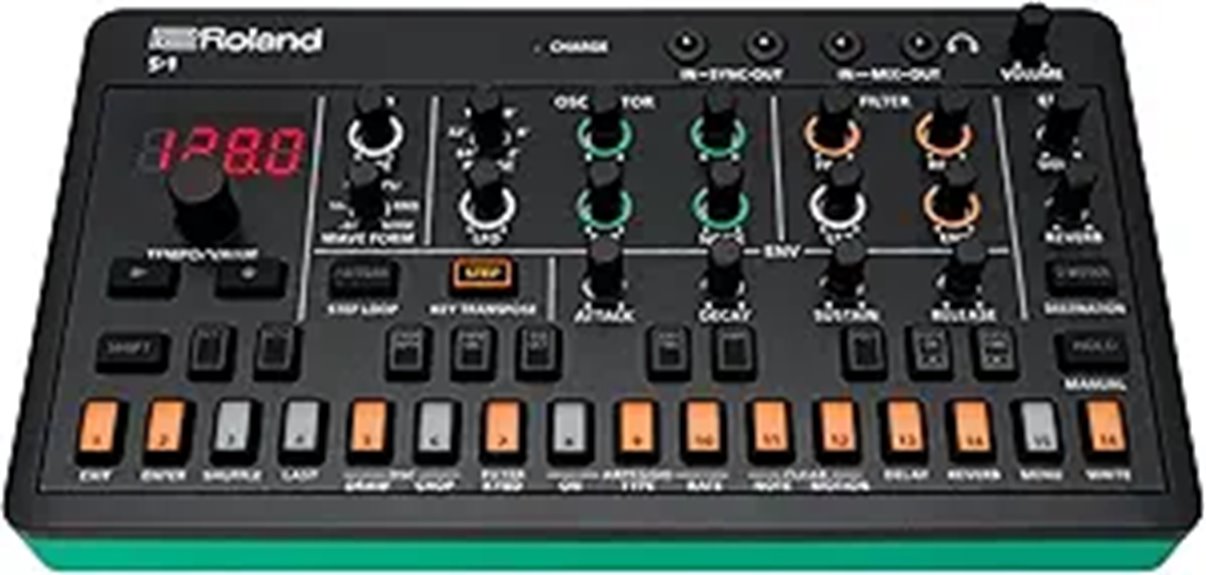
The Roland S-1’s compact form factor and authentic SH-101 sound make it an ideal choice for producers who need classic analog character without sacrificing valuable desk space in their home studios. You’ll access the legendary SH-101’s snappy basses and expressive leads through Roland’s Analog Circuit Behavior technology, which recreates the original’s analog warmth with digital precision. The S-1 offers four-voice polyphony across mono, poly, unison, and chord modes, while its oscillators deliver square, sawtooth, sub, and noise waveforms for extensive sound design. Its hands-on panel provides immediate control over synthesis parameters, and the onboard sequencer handles pattern creation without requiring external software or hardware.
Best For: Producers and musicians seeking authentic SH-101 analog character in a compact desktop synth for home studios, live performance, and modern music production.
Pros:
- Authentic SH-101 sound recreation using Roland’s Analog Circuit Behavior (ACB) technology
- Compact form factor with hands-on controls ideal for small studio spaces and live performance
- Versatile four-voice polyphony with multiple modes and onboard sequencing capabilities
Cons:
- Limited to four-voice polyphony which may restrict complex chord work
- Micro form factor may make precise control adjustments challenging during live performance
- Sound palette focused primarily on SH-101 character, limiting tonal variety compared to multi-engine synths
Behringer Crave Analog Synthesizer with Sequencer
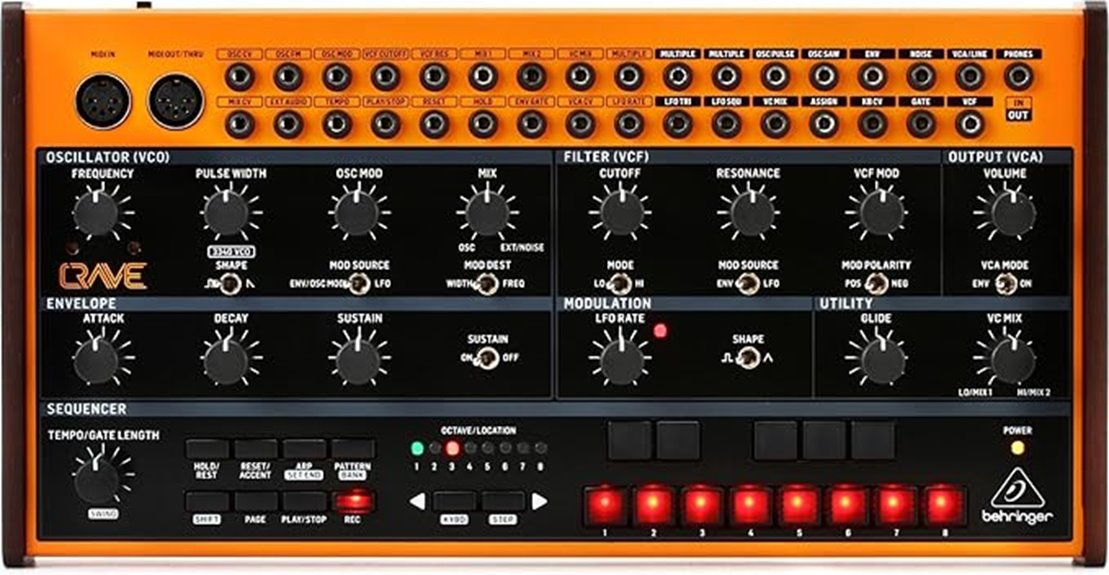
Semi-modular patching capabilities distinguish the Behringer Crave as an exceptional entry point for musicians who want to explore analog synthesis without breaking the bank, offering the tactile experience of cable routing that typically costs three times as much. At $199, you’re getting an 18×14 patch matrix, classic 3340 VCO, and ladder filter that delivers darker tones than Moog’s Mother 32. The 32-step sequencer handles complex patterns without bugs, while SynthTools software extends your editing capabilities. You’ll need to study the manual since documentation’s minimal, but the solid metal construction and 32-key layout provide serious functionality for experimental sound design.
Best For: Musicians and beginners who want to explore analog synthesis and semi-modular patching at an affordable price point without sacrificing sound quality or build construction.
Pros:
- Exceptional value at $199 with solid metal construction and features typically found in synthesizers costing three times as much
- Comprehensive semi-modular capabilities with 18×14 patch matrix encouraging experimentation and diverse sound creation
- Reliable 32-step sequencer with no identified bugs and classic analog sound from 3340 VCO and ladder filter
Cons:
- Minimal documentation requires studying the manual or online tutorials to fully utilize the synthesizer’s capabilities
- SynthTools software lacks real-time sequencer editing functionality, requiring notes to be drawn and stored
- Darker tone profile may not suit all musical styles compared to brighter-sounding alternatives
Behringer Pro VS Mini Hybrid Vector Synthesizer
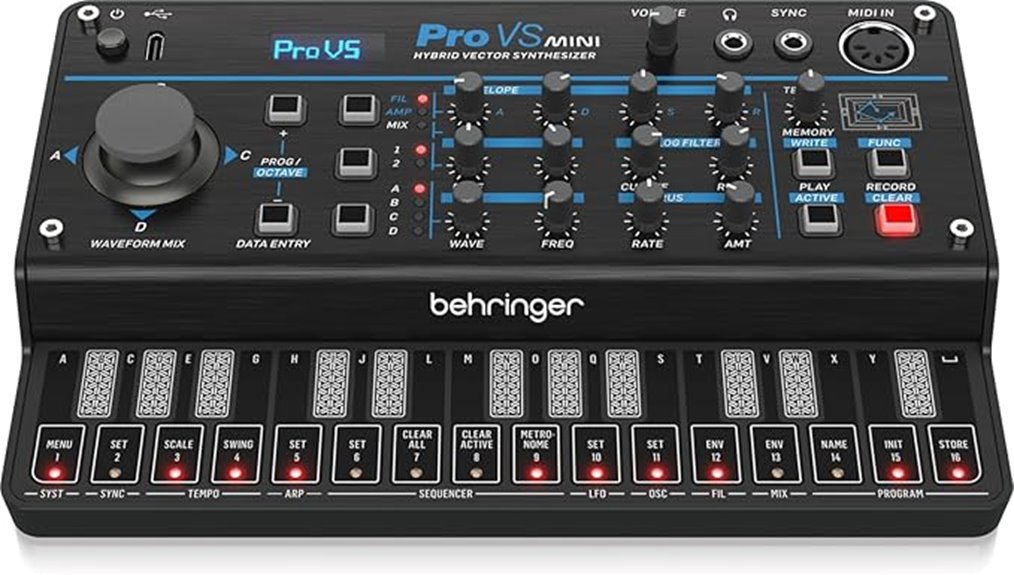
Budget-conscious producers seeking professional vector synthesis capabilities will find exceptional value in the Behringer Pro VS Mini Hybrid Vector Synthesizer, a compact 4-voice powerhouse that delivers 16 vector oscillators, wavetable synthesis, and analog filtering in a remarkably affordable package. You’ll appreciate its intuitive interface featuring numerous hands-on controls, though I’ve found the 32-preset limitation somewhat restrictive for extensive sound libraries. The unit’s 4.6-star rating reflects its impressive sound quality and performance that rivals considerably pricier alternatives, making it an excellent entry point for exploring vector synthesis without the traditional financial commitment.
Best For: Budget-conscious producers, beginners exploring vector synthesis, and home studio enthusiasts who want professional-quality wavetable synthesis capabilities without investing in expensive equipment.
Pros:
- Exceptional value with 16 vector oscillators, wavetable synthesis, and analog filtering at an affordable price point
- Intuitive interface with numerous hands-on controls and clear screen displaying presets and waveforms
- Versatile connectivity options including USB-C, MIDI DIN, and compatibility with external MIDI keyboards
Cons:
- Limited to only 32 presets, which may be restrictive for users wanting extensive sound libraries
- Small, less effective touch keys that work better with an external MIDI keyboard
- Lacks battery power option and additional ports like MIDI out/through and mix in/out
Factors to Consider When Choosing a Desksynth
When I’m selecting a desk synthesizer for my home studio, I’ve learned that understanding the core technical specifications can make the difference between a purchase that enhances my workflow and one that becomes an expensive paperweight collecting dust on my desk. The five critical factors I always evaluate—sound engine architecture, polyphony limitations, sequencing capabilities, connectivity options, and physical construction quality—directly impact both the creative possibilities and long-term reliability of any synthesizer investment. I’ll walk you through each consideration, sharing the practical insights I’ve gained from years of testing various models, so you can make an informed decision that aligns with your specific production needs and budget constraints.
Sound Engine Types
While I’ve tested countless synthesizers over the years, I’ve found that the sound engine represents the most essential factor in determining your synthesizer’s character, capabilities, and overall sonic personality. Analog engines, featuring voltage-controlled oscillators and filters, deliver those warm, rich tones that make basslines thump and leads sing with organic character. Digital engines, whether wavetable or sample-based, offer incredible versatility with pristine clarity and extensive sound libraries that can recreate anything from vintage Rhodes to orchestral strings. Hybrid designs combine both worlds, giving you analog warmth with digital precision and flexibility. When evaluating sound engines, I focus on oscillator types, filter models, and modulation capabilities, since these elements determine whether you’ll achieve your creative vision or find yourself wrestling with limitations.
Polyphony and Voices
Although sound engines capture most of the attention when discussing synthesizers, polyphony determines whether your musical ideas translate into reality or get cut short by technical limitations. I’ve learned this lesson the hard way when chord progressions suddenly drop notes mid-performance because I exceeded the voice count.
Analog synthesizers typically offer 1-16 voices, which sounds restrictive until you realize how creative limitations can spark innovation. Digital synths, however, provide 64 voices or more, supporting complex arrangements without note dropouts. When I’m layering multiple sounds or playing intricate chord voicings, higher polyphony becomes essential for maintaining harmonic richness.
Multi-timbral capabilities add another dimension, allowing distinct patches across different tracks while sharing the total voice allocation, making your home studio workflow considerably more efficient.
Sequencer and Arpeggiator
Beyond polyphony lies the creative heart of pattern creation, where sequencers and arpeggiators transform static sounds into rhythmic compositions that breathe life into your productions. I’ve found that modern desk synthesizers offer sophisticated sequencing capabilities, allowing me to program intricate note patterns with adjustable step lengths, polyrhythms, and real-time recording features that capture spontaneous musical ideas effortlessly. The arpeggiator functionality generates compelling chord sequences automatically, while extensive modulation options provide dynamic control over timing, velocity, and effects parameters. What truly excites me about advanced sequencers is their live automation support, enabling real-time manipulation of filters, pitch, and other parameters during performances, which adds remarkable depth and expressiveness to compositions.
Connectivity and I/O
Connectivity serves as the bridge between your synthesizer and the broader musical ecosystem, determining how seamlessly you’ll integrate new gear into existing setups and future expansions. I prioritize models offering multiple MIDI connections, USB ports, and increasingly, Bluetooth capabilities for wireless control flexibility. Audio output jacks and dedicated headphone outputs accommodate different listening environments, whether I’m monitoring privately or feeding speakers directly.
Advanced I/O systems supporting external synth control expand functionality remarkably, allowing complex routing between multiple devices. I check specifications for simultaneous output capabilities, which enable sophisticated sound manipulation and multi-channel recording scenarios. USB compatibility with existing DAWs streamlines workflow integration, eliminating compatibility headaches that frankly, I’ve encountered too many times before.
Build Quality Materials
When I’m evaluating synthesizer construction, the materials chosen by manufacturers directly influence both the instrument’s longevity and my confidence during performance situations. I’ve noticed that desksynths featuring metal bodies and high-grade plastic components consistently outperform their cheaper counterparts, offering superior resistance to wear and the inevitable studio accidents that happen when I’m working late into the night. Weight often indicates build quality—heavier units typically showcase sturdier construction that handles vibrations and occasional bumps without compromising performance. While lighter models excel for travel situations, I prefer the substantial feel of well-built synths with quality knobs and sliders that provide excellent tactile feedback, enhancing both my studio workflow and live performance confidence.
Price Vs Features
Three fundamental considerations shape every desksynth purchasing decision I make: the features I actually need, the budget I’m working with, and how these two factors intersect to deliver genuine value. I’ve learned that affordable models often provide basic synthesis capabilities and decent sound quality, while pricier units deliver extensive sound design options, expanded connectivity, and larger preset banks. When I’m evaluating options, I analyze user ratings to determine whether features justify the price point, comparing similar-priced competitors to avoid models that compromise too heavily on versatility. Understanding how pricing relates to specific functions like sequencers, modulation matrices, and storage capacity helps me align my creative requirements with budget constraints, ensuring I don’t overpay for features I’ll never use.
Portability and Size
Two critical dimensions determine whether a desksynth will fit seamlessly into my creative workflow: its physical footprint on my desk and its practicality for transport between different music-making environments. I’ve found that portable models weighing 1-5 pounds offer the sweet spot for flexibility, though I’ll sacrifice some features for that mobility. Battery-powered options providing around 6 hours of operation eliminate my dependency on wall outlets during jam sessions or performances. Built-in speakers and microphones reduce my equipment setup time, which honestly saves me from cable chaos more often than I’d like to admit. Rack-mountable units strike an excellent balance, integrating into my existing studio while remaining transportable when gigs demand it.
On a final note
I’ve walked you through eight outstanding desktop synthesizers that’ll genuinely elevate your music production, each offering distinct sonic capabilities and workflow advantages. Whether you’re drawn to the OP-XY’s portable versatility, the Minitaur’s thunderous bass lines, or the Hydrasynth’s expansive digital palette, there’s something here for every producer’s needs and budget. Choose based on your specific musical goals, available space, and desired sound palette.

